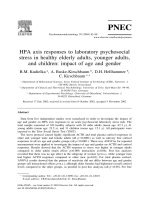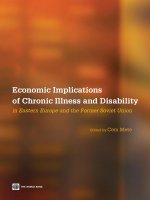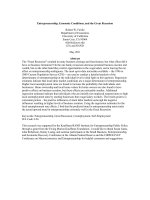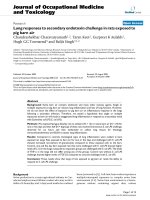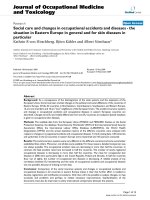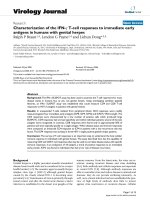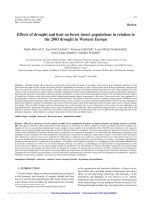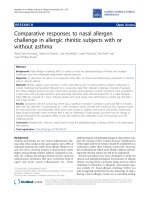the jobs crisis; household and government responses to the great recession in eastern europe and central asia (wb, 2011)
Bạn đang xem bản rút gọn của tài liệu. Xem và tải ngay bản đầy đủ của tài liệu tại đây (3.28 MB, 136 trang )
The Jobs Crisis
Household and Government Responses to
the Great Recession in Eastern Europe
and Central Asia
DIRECTIONS IN DEVELOPMENT
Human Development
RUSSIAN FEDERATION
KAZAKHSTAN
KYRGYZ REP.
TAJIKISTAN
UZBEKISTAN
ESTONIA
BELARUS
ROMANIA
HUNGARY
CZECH REP.
SLOVAK REP.
SERBIA
FYR
MACEDONIA
MONTENEGRO
BOSNIA AND HERZ.
CROATIA
ALBANIA
SLOVENIA
MOLDOVA
BULGARIA
POLAND
UKRAINE
LATVIA
LITHUANIA
RUSSIAN FED.
TURKMENISTAN
TURKEY
GEORGIA
ARMENIA
AZERBAIJAN
KOSOVO
Black Sea
Caspian
Sea
Baltic
Sea
Aral Sea
Mediterranean Sea
IBRD 38280
JULY 2010
0150
0 150 300 Miles
300 Kilometers
This map was produced by the Map Design Unit of The World Bank.
The boundaries, colors, denominations and any other information shown on
this map do not imply, on the part of The World Bank Group, any judgment
on the legal status of any territory, or any endorsement or acceptance of
such boundaries.
The Jobs Crisis
The Jobs Crisis
Household and Government Responses
to the Great Recession in Eastern Europe
and Central Asia
© 2011 The International Bank for Reconstruction and Development/The World Bank
1818 H Street NW
Washington DC 20433
Telephone: 202-473-1000
Internet: www.worldbank.org
All rights reserved
1 2 3 4 14 13 12 11
This volume is a product of the staff of the International Bank for Reconstruction and
Development/The World Bank. The findings, interpretations, and conclusions expressed in this
volume do not necessarily reflect the views of the Executive Directors of The World Bank or the
governments they represent.
The World Bank does not guarantee the accuracy of the data included in this work. The bound-
aries, colors, denominations, and other information shown on any map in this work do not imply
any judgement on the part of The World Bank concerning the legal status of any territory or the
endorsement or acceptance of such boundaries.
Rights and Permissions
The material in this publication is copyrighted. Copying and/or transmitting portions or all of
this work without permission may be a violation of applicable law. The International Bank for
Reconstruction and Development/The World Bank encourages dissemination of its work and will
normally grant permission to reproduce portions of the work promptly.
For permission to photocopy or reprint any part of this work, please send a request with com-
plete information to the Copyright Clearance Center Inc., 222 Rosewood Drive, Danvers, MA
01923, USA; telephone: 978-750-8400; fax: 978-750-4470; Internet: www.copyright.com.
All other queries on rights and licenses, including subsidiary rights, should be addressed to the
Office of the Publisher, The World Bank, 1818 H Street NW, Washington, DC 20433, USA; fax:
202-522-2422; e-mail:
ISBN: 978-0-8213-8742-9
eISBN: 978-0-8213-8743-6
DOI: 10.1596/978-0-8213-8742-9
Library of Congress Cataloging-in-Publication Data
The jobs crisis : household and government responses to the great recession in Eastern Europe
and Central Asia.
p. cm. — (Directions in development)
Includes bibliographical references.
ISBN 978-0-8213-8742-9 (alk. paper) — ISBN 978-0-8213-8743-6
1. Manpower policy—Europe, Eastern. 2. Europe, Eastern—Social policy. 3. Recessions—Europe,
Eastern. I. World Bank.
HD5764.7.A6J63 2011
331.12'0420947—dc22
2011006400
Cover photo: Unemployment office in Kurgan, Russia. Photo by ITAR-TASS / Alexander
Alpatkin.
Cover design: Naylor Design.
v
Foreword xi
Acknowledgments xiii
Abbreviations xv
Overview xvii
Chapter 1 Introduction 1
Eastern Europe and Central Asia Were
Particularly Hard Hit by the Global GDP
Contraction, the First Since World War II 2
Four Transmission Channels: How the Crisis
Affects Household Welfare 5
About This Report 7
Note 11
Chapter 2 Labor Market Impacts 13
Labor Markets Were the Main Transmission
Channel for the Crisis 14
Unemployment Increased Sharply 15
Workers Who Kept Their Jobs Took Home
Smaller Paychecks 20
Contents
In Bulgaria, Labor Market Adjustments
Were More Severe on Roma and Turkish
Minorities 26
The Employment Decline Varied across
Countries Due Not Only to Labor Market
Regulations but also to a Confluence
of Factors 26
Foreign Labor Market Conditions Spawned
Domestic Consequences 29
Notes 31
Chapter 3 Household Coping Mechanisms 33
Crisis Impacts Prompt Steps to Increase
Disposable Income and Reduce Expenditures 34
Households That Experienced a Shock
Sought to Cope by Increasing Disposable
Income 37
Households That Experienced a Shock also
Coped by Reducing Expenditures during
the Crisis 41
Poor and Minority Households Coped by
Adopting Riskier Coping Strategies than
Rich Households 46
Notes 51
Chapter 4 Social Policy Responses to Protect Households 55
Four Tools Have Been Deployed to Protect People
from the Effects of the Crisis 56
Labor Market Measures Have Been Deployed
and Early Results Are Encouraging 57
Social Assistance Measures Have Been Leveraged
and the Response Is Mixed 64
Minimum Pensions Were Used as a Crisis Response
to Protect the Poor 70
Government Education Spending Was
Protected More than Government Health
Sector Spending in 2009, and Some
Governments Tried to Shield the Poor from
Service Disruptions 70
Notes 76
vi Contents
Chapter 5 Improving Responses to Subsequent Crises 79
Automatic Stabilizers 82
Adjusters 84
Starters 87
Crisis Responses Require Fiscal Discipline,
Planning, and Data 90
More Work on Crisis Responses Is Needed 92
Notes 92
References 95
Boxes
1.1 Crisis Response Surveys 8
3.1 Methodology to Assess the Social Impacts of the
2009 Crisis 42
3.2 The Impacts of Past Crises on Education Outcomes
Were Mixed 44
3.3 Most Impacts of Past Crises on Health Outcomes
Were Negative 47
3.4 Serbia Roma Crisis Assessment 51
4.1 Eastern European and Central Asian Countries
Used the Crisis as an Impetus to Initiate or
Accelerate Structural Adjustments to Reduce High
Fiscal Deficits 73
Figures
O.1 GDP Contracted More Significantly in Eastern
Europe and Central Asia in 2009 Relative to Other
Regions and the Recovery in 2010 Was also More
Muted than in Other Regions xviii
O.2 Unemployment Increased in Most of Eastern Europe
and Central Asia between 2008 and 2009 xx
O.3 Far More Workers Took Home Smaller Paychecks
than Lost Their Jobs xxi
O.4 Households Tried to Increase Income or Reduce
Expenditures to Mitigate the Impacts of the Crisis xxiii
O.5 Crisis-affected Households Increased Vulnerability
to Future Shocks by Adopting Risky Coping
Strategies xxiv
O.6 Three Pillars to an Effective Crisis Response xxviii
Contents vii
1.1 GDP Contracted More Significantly in Eastern
Europe and Central Asia in 2009 Relative to
Other Regions 2
1.2 Twenty of 30 Eastern European and Central Asian
Economies Contracted in 2009 3
1.3 Years of Development in Eastern Europe and
Central Asia Were Undone by the 2009 Recession,
Which Was More Severe than Past Financial Crises
in the Region 4
1.4 Fiscal Positions Deteriorated Substantially in
Many Eastern European and Central Asian
Countries, 2008–10 6
1.5 Economic Crises Affect Households through Four
Main Transmission Channels 7
2.1 Firm Responses to Demand Shocks 15
2.2 In Four Eastern European and Central Asian Countries,
the 2009 Crisis Affected Most Households through the
Labor Market Channel 16
2.3 Unemployment Increased in Most Eastern European
and Central Asian Countries between 2008 and 2009 17
2.4 In a Majority of Eastern European and Central Asian
Countries, Males Made Up a Bigger Fraction of the
Registered Unemployed in 2009 Relative to 2008 18
2.5 Youth Unemployment Rates in Eastern Europe and
Central Asia Were Twice Those of Adult Unemployment
Rates in 2009 According to LFS Data 19
2.6 Long-Term Unemployment Increased Dramatically in
Some Countries between End–2008 and End–2009 20
2.7 Number of Registered Job Seekers per Vacancy
Increased between 2008 and 2009, Revealing a Tighter
Labor Market in Most Countries 21
2.8 Far More Workers Took Home Smaller Paychecks than
Lost Their Jobs 22
2.9 Education Shielded Some Workers from Job Losses, but
Not from Earnings Reductions 23
2.10 Part-Time and Temporary Employment Increased from
Q4 2008 to Q4 2009, Albeit from a Low Base 24
2.11 Real Wages Declined Sharply in Some Eastern European
and Central Asian Countries, and Increased in Others
from Q4 2008 to Q4 2009 25
viii Contents
2.12 In Bulgaria, Roma and Turkish Ethnic Minorities Were
Hit Harder by Labor Market Shocks than Nonminorities 26
2.13 The Employment Growth to Economic Growth
Relationship Varied Considerably across Eastern
European and Central Asian Countries, 2008–09 28
2.14 Remittances Declined Significantly in 2009 across
Eastern Europe and Central Asia 30
2.15 Remittance Inflows Contracted Significantly in Some
Eastern European and Central Asian Countries between
2008 and 2009 31
3.1 Households Tried to Increase Income or Reduce
Expenditures to Mitigate the Impacts of the Crisis 35
3.2 Households Coped with the Crisis by Adopting Measures
to Increase Incomes or Decrease Household Expenditures 36
3.3 Households Increased Labor Supply in Response
to the Crisis 38
3.4 In Bulgaria, Wealthy Households Were More Likely
to Succeed in Finding Additional Work than Poor
Households 39
3.5 In Montenegro, Poor Households Were More Likely
to Increase Labor Supply in Agriculture 40
3.6 Households That Were Directly Affected by the Crisis
Increased Their Vulnerability to Future Shocks by
Adopting Riskier Coping Strategies than Crisis-Unaffected
Households 49
3.7 In Bulgaria, Roma and Turkish Minority Households
Adopted Riskier Coping Strategies than the Majority 50
4.1 A Typology of Labor Market Policy Measures Enacted
to Mitigate the Impact of the Crisis 58
4.2 Unemployment Insurance Was the First Government
Social Response to Households Affected by the Crisis 59
4.3 Unemployment Benefits Cover Only a Fraction of
Total Registered Unemployed in Many Eastern European
and Central Asian Countries 60
4.4 Informal Sector Employment Is Sizable in Some
Countries and These Workers Generally Are Not Covered
by Unemployment Insurance 61
4.5 In Ukraine, Higher Proportions of the Unemployed
Have Lost Coverage of Unemployment Insurance
Benefits since the Onset of the Crisis 62
Contents ix
4.6 Active Labor Market Program Budgets Were Fortified
in Many Countries to Reduce Long-Term Unemployment 63
4.7 Last-Resort Social Assistance Programs Account for a
Small Share of Social Assistance Spending and Cover a
Small Share of the Poor in Many Eastern European and
Central Asian Countries 65
4.8 Performance Varied among Last-Resort Social Assistance
Programs as a Crisis Response 66
4.9 Some Eastern European and Central Asian Countries
Reduced Real Health and Education Spending during
the Crisis 71
5.1 Three Pillars to an Effective Crisis Response 80
5.2 Social Transfers Increased in Most Countries in 2009
Relative to 2008 91
Tables
3.1 Health and Some Education Coping Strategies Were
Adopted by Households across Four Eastern European
and Central Asian Countries 44
4.1 Mechanisms for Governments to Mitigate the Impact
of the Crisis on Households 56
4.2 Measures Taken by Eastern European and Central
Asian Countries to Improve the Last-Resort Social
Assistance Response to the Crisis 69
xContents
xi
The financial crisis and the ensuing economic downturn, the worst since
the Great Depression in the 1930s, went hand in hand with tightening of
credit markets, bank failures, firm closures, and high demand for social
safety nets. In no region of the world were such consequences more pro-
nounced than in the countries of Eastern Europe and Central Asia.
This report, The Jobs Crisis: Household and Government Responses to the
Great Recession in Eastern Europe and Central Asia, brings together evi-
dence that World Bank teams have collected on the impact of the crisis
on households and families in Eastern Europe and Central Asia. The mul-
tiple monitoring tools employed in this study range from qualitative stud-
ies to the fielding of Crisis Response Surveys, and from extensively using
administrative data to collecting information on policy responses from
many client governments in the region.
This report shows how the crisis was felt by Eastern European and
Central Asian households. Not only did unemployment rise sharply but it
also lasted longer. The report also shows that the pain of the recession was
broader, with workers taking home smaller paychecks as firms offered
lower wage rates and fewer hours of work to their workers. The Jobs Crisis
finds that households used a variety of ways to cope with the crisis. In
some cases, those strategies put households at a higher long-term risk, for
F oreword
example, by reducing spending on health care. Thankfully, most house-
holds kept their children in school, but the longer crisis conditions con-
tinue, the higher the chances are that education investments will be
reduced in favor of short-term survival.
The Jobs Crisis presents an account of how governments reacted to the
crisis through social policy reforms and initiatives—and how such
responses could be improved in the future. Unemployment insurance
benefits played a particularly important cushioning role, but coverage of
the unemployed tended to be limited. Poverty-targeted social assistance
programs often reacted only with a lag and suffered from low coverage in
some countries. Despite severe fiscal pressures, however, governments
tended to protect education budgets, and health budget cuts were often
smaller than the overall gross domestic product contraction. Although
both education and health sectors are in need of structural reforms in
many countries, protecting those budgets while implementing long-term
reforms is crucial to ensuring basic human capital investments.
Strengthening automatic stabilizers, adjusting program parameters, and
starting new social programs can help governments respond better to
crises in the future.
We hope that The Jobs Crisis will find interested readers in the region
and beyond, as it is one of the first systematic accounts of the conse-
quences of the current macroeconomic crisis on the welfare of people.
Philippe H. Le Houérou
Vice President, Europe and Central Asia
The World Bank
xii Foreword
xiii
This report was prepared by a team led by Mohamed Ihsan Ajwad and
comprising Mehtabul Azam, Basab Dasgupta, Lire Ersado, Sarojini
Hirshleifer (Consultant), Aylin Isik-Dikmelik, Johannes Koettl, Arvo
Kuddo, Nadezhda Lepeshko, Isil Oral, Emily Sinnott, Owen K. Smith,
and Julia Smolyar.
The team benefited from contributions from Meltem Aran
(Consultant), Rajna Cemerska-Krtova, Ufuk Guven, Francisco
Haimovich (Inter-American Development Bank), Oleksiy Ivaschenko,
Laurie Joshua (Consultant), Sachiko Kataoka, Igor Kheyfets, Andrei R.
Markov, Ambar Narayan, Daniel Owen, Katerina Petrina, Cristobal
Ridao-Cano, Jan J. Rutkowski, Carolina Sanchez-Paramo, Pia Helene
Schneider, Anita M. Schwarz, Ivan Shulga, Lars M. Sondergaard, Victoria
Strokova, Ramya Sundaram, Emil Daniel Tesliuc, and Carolyn Turk.
The work was conducted under the general guidance of Jesko
Hentschel and Indermit Gill. Excellent advice was received from Tamar
Manuelyan Atinc, Arup Banerji, Gordon Betcherman (University of
Ottawa), Charles Griffin, Kathy A. Lindert, Mamta Murthi, Truman
Packard, M. Willem van Eeghen, and Abdo Yazbeck.
Acknowledgments
The work benefited greatly from the following peer reviewers: Louise
J. Cord, Aline Coudouel, Andrew D. Mason, and Marijn Verhoeven.
Excellent suggestions were received from David Balan, Amit Dar,
Shivanthi Gunasekera, and William F. Maloney.
Katerina Timina served as the program assistant. Bonita J. Brindley and
EEI Communications edited the document. Dorota Kowalska coordinated
the launch and dissemination of the publication. Paola Scalabrin, Aziz
Gökdemir, and Deb Barker of the World Bank Office of the Publisher
coordinated book production including design, editing, typesetting, print-
ing, and electronic conversion.
xiv Acknowledgments
xv
ALMP Active Labor Market Program
CRS Crisis Response Survey
ESF European Social Fund
EU European Union
GDP Gross Domestic Product
GMI Guaranteed Minimum Income
HBS Household Budget Survey
HIF Health Insurance Funds
ILO International Labour Organization
IMF International Monetary Fund
ISKUR Turkish Employment Agency
LFS Labor Force Survey
LRSA Last-Resort Social Assistance
LVL Latvian Lat
MIP Medical Insurance Program
NGO Nongovernmental Organization
OECD Organisation for Economic Co-operation and
Development
OSI Open Society Institute
Abbreviations
PSM Propensity Score Matching
UI Unemployment Insurance
UNICEF United Nations Children’s Fund
WWS Workplaces with Stipends
YoY Year over Year
xvi Abbreviations
xviixvii
Introduction
The onset of the financial crisis was evident as early as mid-2007 when a
real estate bubble in the United States and parts of Western Europe
imploded, triggering multiple bank failures. In a short period of time, prop-
erty values plummeted, the value of retirement accounts shrank, house-
hold savings evaporated, and general consumer and producer confidence
disappeared. The financial crisis swiftly expanded into an economic crisis
throughout America and Western Europe, from where it spread to devel-
oping countries that had depended on foreign direct investment, consumer
and mortgage credit, trade, and remittances. By early 2009, it was clear that
this economic downturn would be more severe than any crisis since the
Great Depression, prompting some to refer to it as the “Great Recession.”
Eastern European and Central Asian countries were hit particularly
hard (see figure O.1). During 2009, global gross domestic product (GDP)
contracted for the first time since World War II—about 2.2 percent—but
across the region,
1
the average contraction was more than 5 percent
and 20 of 30 economies recorded declines in GDP. Simulations of
poverty rates given GDP contractions indicate that by the end of 2010,
there could be 10 million more poor people in Eastern Europe and
Central Asia, relative to baseline precrisis projections. Estonia, Latvia,
Overview
xviii Overview
and Lithuania were among the hardest hit with sharp economic contrac-
tions of 14 to 18 percent. Large countries also suffered severe GDP con-
tractions: the Russian Federation, 7.9 percent; Turkey, 4.7 percent; and
Ukraine, 15.1 percent.
Unprecedented fiscal pressures emerged in many of the region’s coun-
tries. Public finances deteriorated sharply in 2009, with an average decline
in the fiscal position equivalent to 3.8 percent of GDP. As growth weak-
ened, government revenues fell and spending on social protection pro-
grams rose for those countries worst hit by the economic downturn.
The fiscal reaction to the crisis varied across the region. Three oil and
gas exporters—Azerbaijan, Russia, and Uzbekistan—suffered the largest
decline in the fiscal balance in 2009. Abundant public savings built up in
recent boom years allowed these countries to put in place expansionary
fiscal policies. In contrast, for a number of countries in Eastern Europe,
Figure O.1 GDP Contracted More Significantly in Eastern Europe and Central Asia
in 2009 Relative to Other Regions and the Recovery in 2010 Was also More Muted
than in Other Regions
–6
–4
–2
0
2
percent change
4
6
8
10
12
Eastern Europe and
Central Asia
Latin America and
the Caribbean
Middle East and
North Africa
East Asia and
the Pacific
South Asia
Sub-Saharan Africa
2009 2010
GDP growth for 2009 and forecasts for 2010
Source: World Bank staff calculations using IMF World Economic Outlook Database, October 2010.
Note: Regional averages include only low- and middle-income countries based on World Bank classification of
regions. Eastern Europe and Central Asia also includes Croatia, Czech Republic, Estonia, Hungary, Latvia, Poland,
Slovak Republic, and Slovenia.
the boom years had led to growing public spending commitments with
no accumulation of buffer-stock savings.
About This Report
The impact of economic crises on household welfare typically are
traced through four main transmission channels: (i) financial markets,
via reduced access to credit, eroding savings, and sinking asset values;
(ii) product markets, via lower growth and production, and relative
price changes; (iii) labor markets, via falling employment, wages, and
remittances; and (iv) government services, via declining education,
health, and social protection services. Although these four transmis-
sion channels all affect household welfare, this report focuses on labor
markets and government services.
This report presents the findings that emerged from a heightened
monitoring effort launched by the World Bank to track the impacts of
deteriorating macroeconomic conditions on families and government
social responses to the crisis in Eastern European and Central Asian coun-
tries. The report synthesizes findings from administrative sources (for
example, public employment offices, social benefits monitoring), Crisis
Response Surveys, and government social responses. The report explores
the following topics: (i) labor market adjustments, from firms halting new
hiring, laying off workers, and reducing the wage bill by changing the
hours of work, wage rates, and so on; (ii) coping strategies adopted by
households, including measures to increase household income and reduce
household expenditures following an income shock; and (iii) government
social initiatives to protect household welfare, sometimes concurrently
with tough fiscal consolidation measures. The report ends with reflections
on policy options for governments to better prepare themselves to
respond to future shocks.
Labor Market Impacts
Crisis Response Surveys confirm that labor market deterioration was the
main transmission channel of the crisis to households, as firms laid off
workers, halted hiring, and reduced their wage bill. Year over year (YoY)
increases in registered unemployment in 27 Eastern European and
Central Asian countries averaged 30 percent, increasing from 9.4 to 12.2
million between December 2008 and 2009 (see figure O.2).
Unemployment rates rose sharply in Estonia, Latvia, and Lithuania, but
Overview xix
xx Overview
also in larger countries such as Russia, Turkey, and Ukraine. Job losses have
occurred across the board, but the construction, retail, and manufactur-
ing sectors were hit particularly hard. Among all workers, the share of
men among registered job seekers increased, likely because the hardest hit
sectors of the economy were typically male dominated. New entrants to
the labor market faced difficult employment prospects, with youth
unemployment reaching record highs of 25 percent (twice the adult rate)
in 17 Eastern European and Central Asian countries in 2009.
Unemployment has lasted longer and competition for jobs has
increased considerably since the crisis. Among 20 countries, long-term
unemployment increases were sharpest in Estonia, Latvia, and Lithuania.
People who have remained unemployed for long periods have had diffi-
culty getting rehired because of stigma, discouragement, or deterioration
of their skills. Increasingly, long-term registered unemployment has fallen
Figure O.2 Unemployment Increased in Most of Eastern Europe and Central Asia
between 2008 and 2009
–20
0
20
40
60
80
100
120
140
160
percent change
Macedonia, FYR
Kazakhstan
Bosnia and Herzegovina
Montenegro
Croatia
Poland
Romania
Bulgaria
Slovak Republic
EU-15
EU-27
Hungary
Turkey
Russian Federation
Slovenia
Ukraine
Czech Republic
Moldova
Latvia
Lithuania
Estonia
Source: Kuddo (2010a) using various Labor Force Surveys (rather than administrative data).
Note: EU-15 countries are Austria, Belgium, Denmark, Finland, France, Germany, Greece, Ireland, Italy, Luxembourg,
Netherlands, Portugal, Spain, Sweden, and the United Kingdom. EU-27 countries are EU-15 plus Bulgaria, Cyprus,
Czech Republic, Estonia, Hungary, Latvia, Lithuania, Malta, Poland, Romania, Slovak Republic, and Slovenia.
Overview xxi
on youth, low-skilled workers, and minority ethnic groups. These groups
also are more prone to poverty and social exclusion, and hence long spells
of unemployment can have a more permanent impact on these groups
than other vulnerable groups.
As prevalent as job losses were in 2009, the pain of the recession was
far more broad-based. Workers who kept their jobs took home smaller
paychecks (see figure O.3). Firms implemented measures to reduce their
wage bill, including reducing hours of work and wage rates, and increas-
ing administrative leave, wage arrears (mainly in member countries of the
Commonwealth of Independent States), and temporary contracts.
Although these measures may have muted worker layoffs to some extent,
household welfare deteriorated as take-home pay shrank. Data from three
Crisis Response Surveys indicated that in Bulgaria, six times as many
workers took home smaller paychecks than lost their jobs; in Montenegro,
it was four times as many workers; and in Romania, it was three times as
many workers.
Figure O.3 Far More Workers Took Home Smaller Paychecks than Lost Their Jobs
5.1
2.5
5.3
15.4
6.7
12.6
15.0
2.2
2.7
0
5
10
15
20
25
30
35
40
Bulgaria Montenegro Romania
percent of workers
job loss
reduced earnings working same or more hours
reduced earnings working less hours
working age individuals reporting working
hours, wage rate, and employment reduction
Source: Azam 2010.
Note: The denominator is workers working in the last period (current workers not working in the retrospective
period are excluded). For Romania and Montenegro, current workers who did not have a job in the retrospective
period could not be identified, so the denominator is current workers plus the workers who quit or lost their job
between the two periods; the values underestimate the effects.
xxii Overview
The employment decline for each percent of GDP contraction
varied widely across countries. Relatively low worker firing costs in
Estonia and Latvia led to a high employment contraction; Lithuania
and Turkey reduced real hourly wages significantly, leading to a smaller
employment contraction; Ukraine and the former Yugoslav Republic of
Macedonia provided subsidies to companies that agreed to retain
workers, leading to less unemployment; Turkey witnessed a shift in
employment from industry to agriculture and services, most likely into
the informal sector and unpaid family labor (LFS); and, in Croatia, rel-
atively inflexible labor regulations led firms to hold on to employees
early on in the crisis, but as the crisis dragged on, layoffs increased. As
such, the employment-to-GDP relationship depended heavily on
worker firing costs, firm behavior to shrink their wage bill, government
interventions, and perceptions about the crisis.
Finally, because the 2009 crisis was a global crisis, deteriorating foreign
labor markets resulted in lower domestic remittance inflows to families.
Here too, the region was hit harder than other regions around the world.
Across the region, official remittance inflows are estimated to have fallen
by 23 percent in 2009, compared with a 6 percent decline across all
developing countries. Armenia, Kazakhstan, Moldova, and Romania are
expected to witness sharp reductions of one-third to one-half of 2008
remittance levels. These remittances have provided vital income for
families and, hence, these reductions could affect household welfare.
Household Coping Mechanisms
Crisis Response Surveys analyzed in Armenia, Bulgaria, Latvia,
Montenegro, and Romania reflected a broad array of measures households
took in the wake of shocks to increase incomes or reduce expenditures (see
figure O.4). Strategies to increase household disposable incomes included
increasing labor supply, borrowing or drawing down on savings, and tap-
ping informal (charitable donations, remittances, cash from friends and
family) and formal transfers (government social safety nets). Strategies to
reduce expenditures included reducing consumption of durable goods, and
also basic welfare items such as food, health care, and education.
Labor supply. Households that experienced an income shock were
more than twice as likely to increase labor supply as households that did
not, although with varying success. Many crisis-affected households sent
nonworking family members to find work, and working family members
Overview xxiii
sought additional work, especially if their hours had been reduced at
their primary jobs.
Savings and borrowing. Few households were able to rely on savings and
more often households increased indebtedness. Vulnerable households
that experienced income shocks were more likely to be already indebted
and without savings.
Informal and formal transfers. Informal transfers were not among the
most important mitigation strategies for most households and the effective-
ness of formal transfers varied in their response to the crisis. In fact, given
the global nature of the crisis, informal transfers such as remittances,
receipts from charities, and help from relatives were also a transmission
channel of the crisis.
Food expenditures. Households reduced food expenditures in five
countries in which Crisis Response Surveys were launched, with some
households reducing the quality and others the quantity of food con-
sumed. Poor households were more likely to adopt this coping strategy,
in some cases putting their nutritional status at risk.
Health care. Households consistently reported reducing health care
expenditures and utilization. As a result, people exposed themselves to a
higher risk of illness, disability, or in extreme cases, death. Crisis-affected
Figure O.4 Households Tried to Increase Income or Reduce Expenditures to
Mitigate the Impacts of the Crisis
Source of shock to
household
Household
responses
Household welfare
impacts
• Labor markets
• Increase disposable
income
• Impact on poverty
• Impact on long-term
human capital
accumulation
• Impact on savings
and assets
• Reduce household
expenditure
• Credit markets
• Product markets
• Government services
• Labor supply
• Dissaving/borrowing
• Informal safety nets
• Formal safety nets
• Durable goods
• Food
• Education/health
• Insurance
• Other
Source: World Bank staff.


